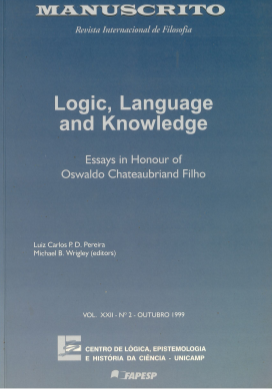Resumen
Plural sentences are commonly assumed to be semantically ambiguous, and to have a collective, a distributive or an intermediate reading. I criticize this view and argue that the distributive/collective/intermediate distinction is better seen not as a case of semantic ambiguity, characteristic of sentences or words as types. I suggest a minimalista view taking the colective/distributive/intermediate distinction to be truth-conditionally irrelevant, and merely qualifying utterances of true simpliciter plural sentences. The intuitions underlying the idea that plural sentences have diferente readings find an acho in our understanding of singular sentences like “Peter played a duet”. I explore this topic. My view of the readings of plural sentences can account for these intuitions. If I am right, number, connected to lexical items and sequences of lexical items in natural languages reveals how underinformative setences are, and underlines the role of interpretation in linguistic communication.
Citas
Gillon, B. (1987). The Readings of Plural Noun Phrases in English, Linguistics and Philosophy 10, pp. 199-219.
Gillon, B. (1990). Plural Noun Phrases and Their Readings: A Reply to Lasersohn, Linguistics and Philosophy 13, pp. 477-485.
Gillon, B. (1992). Toward a Common Semantics for English Count and Mass Nouns, Linguistics and Philosophy 15, pp. 597-639.
Gillon, B. (s.d). Collectivity and Distributivity Internal to English Noun Phrases.
Harnish, R (1976). Logical Form and Implicature, in Bever, T., J. Katz & T. Langendoen (eds.) An Integrated Theory of Linguistic Ability (New York, T. Crowell), pp. 313-391.
Hoeksema, J. (1981). Plurality and Conjunction, in Studies in Modeltheoretic Semantics, Ter Meulen A. (ed.) (Dordrecht,Foris), pp. 63-83.
Kripke, S. (1979). Speaker’s Reference and Semantic Reference, in P.A. French, T.E. Uehling and H.W. Wettstein (eds.) Comtemporary Readings in the Philosophy of Language, (Minneapolis, University of Minnesota Press).
Landman, F. (1989). Groups, I, Linguistics and Philosophy 12, pp. 559-605.
Lasersohn, P. (1989). On Readings of Plural Noun Phrases, LInguistic Inquiry 20, pp. 130-134.
Lasersohn, P. (1990). A Semantics for Groups and Events (New York/London, Garland Publishing).
Lasersohn, P. (1995). Plurality, Conjuction and Events (Dordrecht,Kluwer).
Mackay, T. (1994). Plural Reference and Unbound Pronouns, in Prawitz, D. and D. Westershahl (eds.), Logic and Philosophy of Science in Uppsala (Dordrecht, Kluwer), pp.559-582.
Massey, G. (1976). Tom Dick, And Harry and All the King’s Men, American Philosophical Quarterly vol. 13 nº 2, pp. 89-107.
Schawartzchild, (1996). Pluralities (Dordrechrt, Kluwer).
Vallée, R. (1996).Who Are We?, Canadian Journal of Philosophy, pp. 211-230.

Esta obra está bajo una licencia internacional Creative Commons Atribución 4.0.
Derechos de autor 1999 Manuscrito: Revista Internacional de Filosofia

